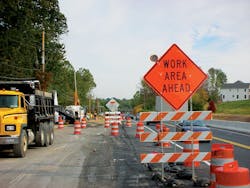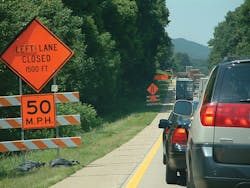PennDOT developing lane reservation system to better manage work zones
As part of its Transportation Systems Management and Operations (TSMO) vision of a less congested, more reliable network, the development of a system to better manage and minimize congestion from work zones is underway at the Pennsylvania Department of Transportation (PennDOT).
This concept, simply known as the Lane Reservation System, was first pitched to PennDOT and the Pennsylvania Turnpike Commission leadership in 2016 through the State Transportation Innovation Council (STIC). The idea of the STIC was introduced by the Federal Highway Administration in 2010 to facilitate the rapid implementation of proven technologies and innovations in place around the country. By learning from lane reservation applications successfully deployed in other states, PennDOT and the Turnpike were able to gain the support necessary to pursue this idea in Pennsylvania.
Too often over the years, traffic management centers (TMCs) would find themselves managing backups on critical roadways during peak travel periods only to learn that the congestion was the result of a work crew blocking a shoulder or travel lane. Without controls on when and where work zones can occur, unnecessary traffic congestion is inevitable. When TMCs are unaware of work zones, they are unable to provide traveler information to motorists. They are also unable to identify any potential conflicts that may occur with other work zones in the area. These types of challenges can lead to safety concerns for both highway workers and the passing motorists.
Pennsylvania’s Lane Reservation System will work to reduce, and hopefully eliminate, these situations by ensuring that crews are performing work during the most appropriate times. The initial concept was designed to establish a system that could reduce work zone conflicts, reduce work zone congestion, improve work zone safety, and improve traveler information. Together, these four needs offer great opportunities for improving the management of work zones in Pennsylvania.
The Lane Reservation System is often compared to online reservation tools, like OpenTable, which can be used for booking a seat at your favorite restaurant. If you are looking for a 7 p.m. Saturday evening reservation at the hot restaurant in town (comparable to a “highly congested” roadway), you are not surprised when you find that none are available. Instead, the reservation system may provide other options to consider like a reservation at 4:30 or perhaps 9 p.m. However, if you want to reserve a table at a less trendy spot (comparable to a “non-congested” roadway), you will often find your “reservation confirmed!” for 7 p.m.
Following the initial discussion with the STIC in 2016, interest in the lane reservation idea expanded to other nearby states through PennDOT’s and the PA Turnpike’s participation in the Smart Belt Coalition. After an unsuccessful bid for a federal Advanced Transportation and Congestion Management Technologies Deployment (ATCMTD) grant in 2017, a pared-down team of PennDOT plus the Ohio and Pennsylvania Turnpikes were successfully awarded a 2018 ATCMTD grant in April of 2019. Over the next year, the team worked hard to develop preliminary documents and requirements and were ready to get the project underway when COVID hit, putting a full stop to the efforts. Unfortunately, as a result of financial hardships resulting from the pandemic, the Turnpikes were unable to continue with the project. PennDOT has always seen the great opportunities that a lane reservation system can offer Pennsylvania and decided to move ahead. Retooling of the project scope established a project that will be split-funded between PennDOT and the ATCMTD grant.
A one-agency project allowed PennDOT to rethink some of the initial requirements and grow the initial vision, including a shift to building the Lane Reservation System as part of its current Advanced Traffic Management System platform (ATMS—the software used for command and control of all PennDOT intelligent transportation systems equipment). Doing so eliminated an additional software platform that would need to connect with other PennDOT systems, including ATMS. PennDOT’s ATMS software is currently managed by the Southwest Research Institute (SwRI) which has deployed similar lane reservation systems in 15 other states around the U.S. By incorporating into ATMS, PennDOT’s deployment will have the benefit of those previous efforts as a starting point to build from.
Building the Lane Reservation System into ATMS also takes advantage of connections already made by ATMS with the Department’s Road Condition Reporting System (RCRS). Today, RCRS is the single system used by PennDOT for capturing information about all incidents and work zones on state roadways, as well as road conditions of key roadways during winter months. The RCRS interface requires connection to the PennDOT network and has been expanded over the years to become a complete event management system, limiting its usability. As the Lane Reservation System joins the ATMS platform, it will become the source for all work zone location data entry. This includes a user-friendly interface that can be used for both the planning and real-time management of work zones. It will also offer users the ability to provide field verification through a mobile device. For the first time, staff will no longer need to contact a traffic management center to report work zone information at the start and end of a project, or when adjustments occur in the field during the project. This feature will lead to much more timely and accurate work zone data being captured, while freeing up TMCs to focus on situational awareness rather than work zone event entry during peak periods.
Another vital aspect of the Lane Reservation System will be utilization of PennDOT’s FREEVAL-PA evaluation tool. FREEVAL-PA is a freeway analysis tool developed by PennDOT, building from software originally created for the North Carolina Department of Transportation. The computational engine is based on the Highway Capacity Manual, and the tool can be used to effectively evaluate Pennsylvania’s limited access highways. FREEVAL-PA will help PennDOT identify the acceptable times available for establishing work zones on various roads throughout Pennsylvania—or, comparing to the dining reservations, those time slots available at the trendy restaurant. More information on FREEVAL-PA can be found at www.freevalpa.com.
The Lane Reservation System will adopt the Work Zone Data Exchange (WZDx) format. The WZDx is intended to ensure consistent data between applications for use by third parties. Data standardization is becoming vital as it is extremely challenging for third-party applications to use data sets from various applications, especially when information is captured and shared in different formats. For example, if Pennsylvania uses “all lanes closed” to define a full closure on a roadway, but Ohio uses “closed,” and New York uses “full closure,” then third-party applications would need a translator to define that each of these terms means the same thing. Incorporating the WZDx as part of the Lane Reservation System will establish a robust data feed that can be provided to industry partners from the onset, and will ensure expandability and preparation for future connected and automated vehicle applications. The Lane Reservation System will also establish an event “data lake.” This data lake will make work zone data more accessible by PennDOT’s partners for use in research, real-time applications, as well as future connected and automated vehicle applications.
Today, the Lane Reservation System concept remains much the same as the initial pitch … reducing work zone conflicts and congestion, as well as improving safety and traveler information. Phase one will focus on the limited access network, but the software will be capable of capturing events on both PennDOT and local roads. Moving to an internet-based application will also open availability to external partners, something not currently possible with the RCRS software. Initial rollout is expected by Spring 2023.


